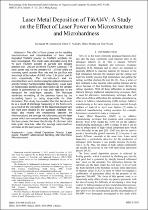 ResearchSpace
ResearchSpace
Laser metal deposition of Ti6Al4V: A study on the effect of laser power on microstructure and microhardness
JavaScript is disabled for your browser. Some features of this site may not work without it.
- ResearchSpace
- →
- Research Publications/Outputs
- →
- Conference Publications
- →
- View Item
| dc.contributor.author |
Mahamood, RM

|
|
| dc.contributor.author |
Akinlabi, ET

|
|
| dc.contributor.author |
Shukla, M

|
|
| dc.contributor.author |
Pityana, Sisa L

|
|
| dc.date.accessioned | 2014-01-24T10:16:21Z | |
| dc.date.available | 2014-01-24T10:16:21Z | |
| dc.date.issued | 2013-03 | |
| dc.identifier.citation | Mahamood, R.M, Akinlabi, E.T, Shukla, M and Pityana, S. 2013. Laser metal deposition of Ti6Al4V: A study on the effect of laser power on microstructure and microhardness | en_US |
| dc.identifier.uri | http://www.iaeng.org/publication/IMECS2013/IMECS2013_pp994-999.pdf | |
| dc.identifier.uri | http://hdl.handle.net/10204/7183 | |
| dc.description | Proceedings of the International MultiConference of Engineers and Computer Scientists 2013 Vol II, IMECS 2013, Hong Kong, 13-15 March 2013. Published in IMECS 2013 conferences. | en_US |
| dc.description.abstract | The effect of laser power on the resulting microstructure and microhardness of laser metal deposited Ti6Al4V powder on Ti6Al4V substrate has been investigated. The tracks were deposited using 99.6 % pure Ti6Al4V powder of particle size ranging between 150 - 200 µm on 99.6% Ti6Al4V substrate. The laser power was varied between 0.8 - 3.0 kW while the scanning speed, powder flow rate and the gas flow rate were kept at the values of 0.005 m/sec, 1.44 g/min and 4 l /min respectively. The microstructure and the microhardness were studied using the optical microscope and the Vickers hardness tester respectively. Layer band or macroscopic banding was observed in all the samples which is phenomenon as it was only reported in the literature for multi-layer deposits. The literature attributed re-melting of the previous layers by the succeeding layers as being responsible for their formation. This study has revealed that this band could be as a result of shrinkage happening in the fusion zone as a result of the interaction of the deposited powder and the melt pool created by the substrate material. This study also reveals the relationship between the microstructure, the average microhardness and the laser power which are comprehensively discussed. The higher the laser power, the lower the density of columnar prior beta grain structure. Also the average microhardness increases as the laser power increases. | en_US |
| dc.language.iso | en | en_US |
| dc.publisher | IMECS 2013 | en_US |
| dc.relation.ispartofseries | Workflow;11990 | |
| dc.subject | Laser Metal Deposition Process | en_US |
| dc.subject | Laser power | en_US |
| dc.subject | Ti6Al4V | en_US |
| dc.subject | Macroscopic Banding | en_US |
| dc.subject | Microhardness | en_US |
| dc.subject | Microstructure | en_US |
| dc.title | Laser metal deposition of Ti6Al4V: A study on the effect of laser power on microstructure and microhardness | en_US |
| dc.type | Conference Presentation | en_US |
| dc.identifier.apacitation | Mahamood, R., Akinlabi, E., Shukla, M., & Pityana, S. L. (2013). Laser metal deposition of Ti6Al4V: A study on the effect of laser power on microstructure and microhardness. IMECS 2013. http://hdl.handle.net/10204/7183 | en_ZA |
| dc.identifier.chicagocitation | Mahamood, RM, ET Akinlabi, M Shukla, and Sisa L Pityana. "Laser metal deposition of Ti6Al4V: A study on the effect of laser power on microstructure and microhardness." (2013): http://hdl.handle.net/10204/7183 | en_ZA |
| dc.identifier.vancouvercitation | Mahamood R, Akinlabi E, Shukla M, Pityana SL, Laser metal deposition of Ti6Al4V: A study on the effect of laser power on microstructure and microhardness; IMECS 2013; 2013. http://hdl.handle.net/10204/7183 . | en_ZA |
| dc.identifier.ris | TY - Conference Presentation AU - Mahamood, RM AU - Akinlabi, ET AU - Shukla, M AU - Pityana, Sisa L AB - The effect of laser power on the resulting microstructure and microhardness of laser metal deposited Ti6Al4V powder on Ti6Al4V substrate has been investigated. The tracks were deposited using 99.6 % pure Ti6Al4V powder of particle size ranging between 150 - 200 µm on 99.6% Ti6Al4V substrate. The laser power was varied between 0.8 - 3.0 kW while the scanning speed, powder flow rate and the gas flow rate were kept at the values of 0.005 m/sec, 1.44 g/min and 4 l /min respectively. The microstructure and the microhardness were studied using the optical microscope and the Vickers hardness tester respectively. Layer band or macroscopic banding was observed in all the samples which is phenomenon as it was only reported in the literature for multi-layer deposits. The literature attributed re-melting of the previous layers by the succeeding layers as being responsible for their formation. This study has revealed that this band could be as a result of shrinkage happening in the fusion zone as a result of the interaction of the deposited powder and the melt pool created by the substrate material. This study also reveals the relationship between the microstructure, the average microhardness and the laser power which are comprehensively discussed. The higher the laser power, the lower the density of columnar prior beta grain structure. Also the average microhardness increases as the laser power increases. DA - 2013-03 DB - ResearchSpace DP - CSIR KW - Laser Metal Deposition Process KW - Laser power KW - Ti6Al4V KW - Macroscopic Banding KW - Microhardness KW - Microstructure LK - https://researchspace.csir.co.za PY - 2013 T1 - Laser metal deposition of Ti6Al4V: A study on the effect of laser power on microstructure and microhardness TI - Laser metal deposition of Ti6Al4V: A study on the effect of laser power on microstructure and microhardness UR - http://hdl.handle.net/10204/7183 ER - | en_ZA |





